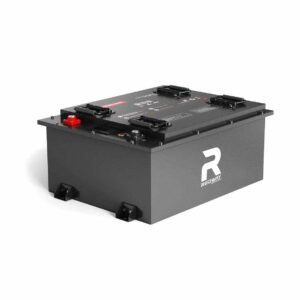How Does a Mobile Car Battery Work and When Should You Replace It?
A mobile car battery powers vehicle electrical systems and starts the engine through electrochemical energy storage. Replace it when experiencing slow cranking, warning lights, or if older than 3-5 years. Regular voltage checks and cleaning terminals extend lifespan. Lithium-ion alternatives are emerging for enhanced performance.
What Are the Best Types of RV Batteries for Your Needs?
How Do Mobile Car Batteries Generate Electrical Power?
Mobile car batteries use lead-acid chemistry where lead plates react with sulfuric acid electrolyte to produce electrons. This creates 12.6-12.8 volts when fully charged. The alternator recharges the battery while driving, reversing the chemical reaction. Deep-cycle variants withstand repeated discharges better than standard starting batteries.

What Are the Warning Signs of Battery Failure?
Key indicators include dim headlights, clicking sounds when turning the key, swollen battery case, and electrical component malfunctions. Voltage below 12.4V at rest signals capacity loss. Parasitic drain exceeding 50mA when off accelerates failure. Extreme temperatures accelerate sulfation – crystal buildup reducing efficiency.
Can You Recharge a Dead Mobile Car Battery?
Smart chargers can revive deeply discharged batteries if voltage remains above 10.5V. Desulfation modes may recover mildly sulfated units. Gel and AGM batteries require specific charging profiles. Never attempt jump-starting frozen batteries – internal shorts could cause explosive hydrogen gas ignition.
How Do Temperature Extremes Affect Battery Performance?
Cold reduces chemical reaction speed, decreasing cranking amps by 33% at 0°F. Heat accelerates water loss and plate corrosion. Each 15°F above 77°F halves battery life. Insulated wraps help in winter; shaded parking preserves summer capacity. Thermal management systems in EVs actively cool battery packs.
| Temperature | Effect on Battery | Performance Loss |
|---|---|---|
| Below 32°F | Reduced electrolyte activity | Up to 40% CCA reduction |
| Above 100°F | Accelerated plate corrosion | 2x faster capacity loss |
Modern batteries incorporate advanced materials like calcium-alloy grids to better withstand temperature fluctuations. In extreme climates, using battery warmers or cooling fans can maintain optimal operating ranges. Recent studies show that batteries maintained at 75°F exhibit 18% longer service life compared to those exposed to seasonal temperature swings.
What Are the Environmental Impacts of Battery Disposal?
Lead-acid batteries contain 60-80% recyclable material but leak toxic lead and sulfuric acid if landfilled. Proper recycling recovers 99% of components. New regulations mandate closed-loop systems – 97% of US batteries get recycled versus 55% globally. Improper disposal contaminates groundwater and causes soil acidification.
Which Emerging Technologies Are Revolutionizing Car Batteries?
Solid-state batteries promise 2-3x energy density with non-flammable electrolytes. Lithium-sulfur tech aims for 500+ mile EV ranges. Graphene-enhanced lead batteries offer 20% longer life. Start-stop systems utilize enhanced flooded batteries (EFB) handling frequent cycling. Wireless charging integration and AI-powered health monitoring are upcoming innovations.
| Technology | Energy Density | Projected Lifespan |
|---|---|---|
| Solid-State | 500 Wh/kg | 10+ years |
| Lithium-Sulfur | 600 Wh/kg | 8 years |
| Graphene Lead | 50 Wh/kg | 7 years |
Recent breakthroughs include silicon-anode batteries achieving 400-mile charges in 15 minutes. Major automakers are investing in sodium-ion technology for low-cost alternatives. Battery-as-a-Service models enable swappable power units, particularly in Asian markets. These innovations aim to reduce reliance on rare earth minerals while improving sustainability.
How Much Does Mobile Car Battery Replacement Typically Cost?
Standard batteries range $100-$250, premium AGM $200-$450. Labor adds $20-$100 depending on vehicle access complexity. Core charges ($10-$30) apply until returning old units. Luxury EVs with high-voltage packs cost $5,000-$20,000. Extended warranties (3-5 years) add 15-30% upfront but cover premature failures.
“Modern vehicles’ power demands require smarter battery management. We’re seeing 48V systems supplement 12V networks for hybrid functions. Battery sensors now track state-of-charge, health, and even predict failures through machine learning algorithms. Proper maintenance remains crucial – 42% of roadside assistance calls stem from preventable battery issues.” – Dr. Elena Torres, Automotive Electrical Systems Specialist
FAQ
- How often should I test my car battery?
- Test voltage monthly and conduct load tests every 6 months. Professional testing before extreme seasons is recommended.
- Can I install a higher-capacity battery?
- Yes if physical size and terminal positions match. Higher CCA (cold cranking amps) improves cold starts but requires proper charging system compatibility.
- Do battery tenders extend battery life?
- Quality maintainers prevent sulfation during storage, potentially doubling battery lifespan. Use models with temperature compensation and desulfation modes.
